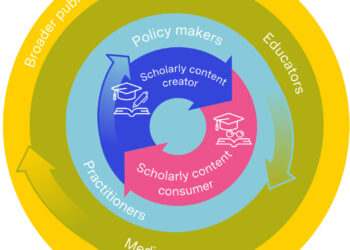At the SSP lunchtime session, Kara Malenfant, Scholarly Communications & Government Relations Specialist at the Association of College and Research Libraries, delivered the first plenary talk.
Without the crutch of slides, Malenfant was exceptionally clear and eloquent in her delivery.
“Librarians need to do a much better job demonstrating the value of libraries on campus,” Malenfant began. At a time when library budgets have been slashed across the board, librarians need to be able to demonstrate that they add value on campus and provide a role in the education of students.
And yet, this is not a time for retrenchment and playing to the status quo.
Malenfant spent most her talk describing a recent piece of research on the future role of academic librarians. The report, Futures Thinking for Academic Librarians: Higher Education in 2025,” sponsored by ACRL, provides nine likely, high-impact scenarios for the future of higher education and the supporting role of librarians. Understanding that universities and their academic libraries take time to adapt to change, the purpose of this study was to start preparing for the likely — or inevitable — future. These scenarios involve:
- A breaking of the textbook monopoly — creating flexible content that allow pieces to be assembled and allow feedback from users.
- “I see what you see” — large touch screens that allow for collaborations.
- “Write here with me” — automated mobile devices that allow students to collect and reference work.
- Bridging the scholar/practitioner divide — open access publishing and open peer review
- Stultifying of scholarship — the antithesis of #4 where the current status quo is maintained and strengthened.
- Everyone is a non-traditional student — moving beyond the 4-year resident college experience.
- Meet the new freshman class — preparing for the digital divide between in-coming tech-savy students and students with need of remedial technological training.
- Increasing threat of cybercrime — as campuses lock down their technology, online privacy and intellectual freedom are compromised.
- “This class brought to you by . . . ” — disaggregated education provided by corporate sponsors.
In each of the nine likely, high-impact scenarios, librarians were generally optimistic. “We are natural Pollyannas,” Malenfant concluded, “always seeing the bright side of these future scenarios and the role of libraries.”
In wrapping up her talk, Malenfant left the audience with some helpful advice on the perception of librarians in this time of change:
Don’t think of librarians as those who hold the purse-strings, because that is not how librarians view themselves.
Discussion
4 Thoughts on "State of the Art I — The Future of Academic Librarians"
Excellent posting Phil, glad you managed to get all the bullet points, what has been interesting and excellent about this SSP IN meeting in my view is that attendees have adapted persona roles, leaving some of the baggage of current roles behind and organizational politics behind. Its refreshing to look at the challenge and project with a view that really covers all stake holder needs, in a creative and collaborative way, personas present were students, faculty, librarians and content producers, some asked to take up the library persona role really learned how the librarians view the challenges a head, as did students, a great format and meeting. Adrian
These are all interesting scenarios but I fail to see how librarians would play a significant role in most of them. There are implications for librarians associated with number 6, but distance learning is hardly new. Ditto for number 7 – colleges and universities have been dealing with the digital divide for some time, and often with programs, such as remedial classes, outside of the library.
I agree with Malenfant that “librarians need to do a much better job demonstrating the value of libraries on campus” but it doesn’t sound like the ACRL report goes very far towards that end.
The futures report is just one small piece of the puzzle. Check out this more recent ACRL publication Value of Academic Libraries: A Comprehensive Research Review and Report http://www.acrl.ala.org/value/, a review of the quantitative and qualitative literature, methodologies and best practices currently in place for demonstrating the value of academic libraries. It provides a clearer understanding of what research about the performance of academic libraries already exists, where gaps in this research occur, and identifies the most promising best practices and measures correlated to performance.
Increasing recognition of the value of libraries and librarians by leaders in higher education, information technology, funding agencies, and campus decision making is one of ACRL’s six strategic priorities. In the coming months, ACRL will be turning its attention to strategies for pursuing the research agenda recommended in the value report, identifying funding sources for projects, and developing training and support materials for our members.




